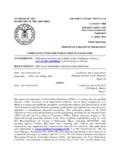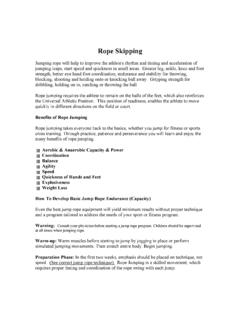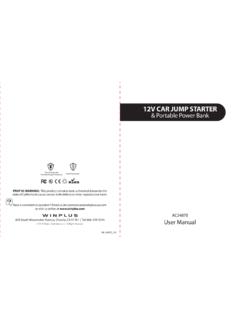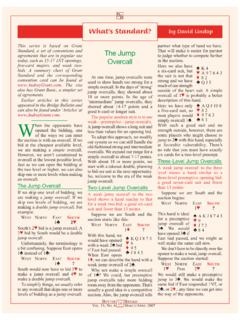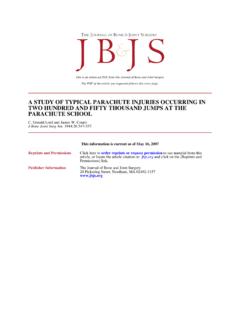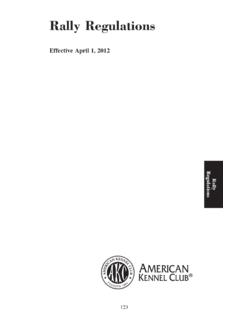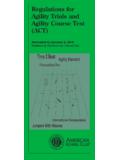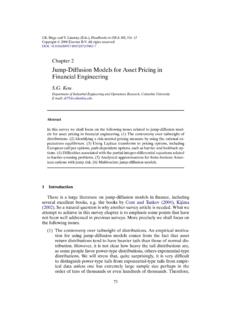Transcription of AJump-DiffusionModel forOptionPricing
1 A jump -Diffusion Modelfor Option PricingS. G. KouDepartment of Industrial Engineering and Operations Research, 312 Mudd Building,Columbia University, New York, New York motion and normal distribution have been widely used in the Black Scholesoption-pricing framework to model the return of assets. However, two puzzles emergefrom many empirical investigations: the leptokurtic feature that the return distribution ofassets may have a higher peak and two (asymmetric) heavier tails than those of the normaldistribution, and an empirical phenomenon called volatility smile in option markets. Toincorporate both of them and to strike a balance between reality and tractability, this paperproposes, for the purpose of option pricing, a double exponential jump -diffusion particular, the model is simple enough to produce analytical solutions for a variety ofoption-pricing problems, including call and put options, interest rate derivatives, and path-dependent options.
2 Equilibrium analysis and a psychological interpretation of the model arealso presented.(Contingent Claims; High Peak; Heavy Tails; Interest Rate Models; Rational Expectations; Overre-action and Underreaction)1. IntroductionDespite the success of the Black Scholes model basedon Brownian motion and normal distribution, twoempirical phenomena have received much attentionrecently: (1) the asymmetric leptokurtic features inother words, the return distribution is skewed to theleft, and has a higher peak and two heavier tails thanthose of the normal distribution, and (2) the volatilitysmile. More precisely, if the Black Scholes model iscorrect, then the implied volatility should be reality, it is widely recognized that the impliedvolatility curve resembles a smile, meaning it is aconvex curve of the strike studies have been conducted to mod-ify the Black Scholes model to explain the twoempirical phenomena.
3 To incorporate the asymmet-ric leptokurtic features in asset pricing, a varietyof models have been proposed:1(a) chaos theory,1 Although most of the studies focus on the leptokurtic featuresunder the physical measure, it is worth mentioning that theleptokurtic features under the risk-neutral measure(s) lead to the volatility smiles in option Brownian motion, and stable processes; see, forexample, Mandelbrot (1963), Rogers (1997), Samorod-nitsky and Taqqu (1994); (b) generalized hyperbolicmodels, including logtmodel and log hyperbolicmodel; see, for example, Barndorff-Nielsen andShephard (2001), Blattberg and Gonedes (1974);(c) time-changed Brownian motions; see, for exam-ple, Clark (1973), Madan and Seneta (1990), Madanet al.
4 (1998), and Heyde (2000). An immediate prob-lem with these models is that it may be difficult toobtain analytical solutions for option prices. Moreprecisely, they might give some analytical formulaefor standard European call and put options, but anyanalytical solutions for interest rate derivatives andpath-dependent options, such as perpetual Americanoptions, barrier, and lookback options, are a parallel development, different models arealso proposed to incorporate the volatility smile inoption pricing. Popular ones include: (a) stochasticvolatility and ARCH models; see, for example, Hulland White (1987), Engle (1995), Fouque et al. (2000);(b) constant elasticity model (CEV) model; see,Management Science 2002 INFORMSVol. 48, No.
5 8, August 2002 pp. 1086 11010025-1909/02/4808/1086$ electronic ISSNKOUA jump -Diffusion Model for Option Pricingfor example, Cox and Ross (1976), and Davydovand Linetsky (2001); (c) normal jump models pro-posed by Merton (1976); (d) affine stochastic-volatilityand affine jump -diffusion models; see, for example,Heston (1993), and Duffie et al. (2000); (e) modelsbased on L vy processes; see, for example, Gemanet al. (2001) and references therein; (f) a numericalprocedure called implied binomial trees ; see, forexample, Derman and Kani (1994) and Dupire (1994).Aside from the problem that it might not be easyto find analytical solutions for option pricing, espe-cially for path-dependent options (such as perpet-ual American options, barrier, and lookback options),some of these models may not produce the asymmet-ric leptokurtic feature (see ).
6 The current paper proposes a new model withthe following properties: (a) It offers an explana-tion for two empirical phenomena the asymmetricleptokurtic feature, and the volatility smile (see 3and ). (b) It leads to analytical solutions to manyoption-pricing problems, including European call andput options (see 5); interest rate derivatives, suchas swaptions, caps, floors, and bond options (see and Glasserman and Kou 1999); path-dependentoptions, such as perpetual American options, bar-rier, and lookback options (see and Kou andWang 2000, 2001). (c) It can be embedded into a ratio-nal expectations equilibrium framework (see 4). (d) Ithas a psychological interpretation (see ).The model is very simple. The logarithm of theasset price is assumed to follow a Brownian motionplus a compound Poisson process with jump sizesdouble exponentially distributed.
7 Because of its sim-plicity, the parameters in the model can be easilyinterpreted, and the analytical solutions for optionpricing can be obtained. The explicit calculation ismade possible partly because of the memorylessproperty of the double exponential paper is organized as follows. In 2, the modelis proposed, is evaluated by four criteria, and is com-pared with other alternative models. Section 3 studiesthe leptokurtic feature. A rational expectations equi-librium justification of the model is given in 4. Somepreliminary results, including the Hh functions, aregiven in Formulae for option-pricing problems,including options on futures, are provided in volatility smiles phenomenon is illustrated in The final section discusses some limitations ofthe The The Model FormulationThe following dynamic is proposed to model the assetprice,S t , under the physical probability measureP.
8 DS t S t = dt+ dW t +d N t i=1 Vi 1 (1)whereW t is a standard Brownian motion,N t isa Poisson process with rate , and Vi is a sequenceof independent identically distributed ( ) nonneg-ative random variables such thatY=log V has anasymmetric double exponential distribution2 3withthe densityfY y =p 1e 1y1 y 0 +q 2e 2y1 y<0 1>1 2>0 wherep q 0,p+q=1, represent the probabilities ofupward and downward jumps. In other words,log V =Yd= +, with probabilityp , with probabilityq (2)where +and are exponential random variableswith means 1/ 1and 1/ 2, respectively, and the nota-tiond=means equal in distribution. In the model,all sources of randomness,N t ,W t , andYs, areassumed to be independent, although this can berelaxed, as will be suggested in For notationalsimplicity and in order to get analytical solutionsfor various option-pricing problems, the drift andthe volatility are assumed to be constants, andthe Brownian motion and jumps are assumed to be2If 1= 2andp=1/2, then the double exponential distribution isalso called the first law of Laplace (proposed by Laplace in 1774),while the second law of Laplace is the normal and Zeng (1999) independently propose the same jump -diffusion model from an econometric viewpoint as a way ofimproving the empirical fit of Merton s normal jump - diffusionmodel to stock price Science/Vol.
9 48, No. 8, August 20021087 KOUA jump -Diffusion Model for Option Pricingone dimensional. These assumptions, however, can beeasily dropped to develop a general the stochastic differential equation (1) givesthe dynamics of the asset price:S t =S 0 exp 12 2 t+ W t N t i=1Vi (3)Note thatE Y =p 1 q 2,Var Y =pq 1 1+1 2 2+ p 21+q 22 , andE V =E eY =q 2 2+1+p 1 1 1 1>1 2>0 (4)The requirement 1>1 is needed to ensure thatE V < andE S t < ; it essentially means thatthe average upward jump cannot exceed 100%, whichis quite are two interesting properties of the dou-ble exponential distribution that are crucial for themodel. First, it has the leptokurtic feature; see Johnsonet al. (1995). As will be shown in 3, the leptokur-tic feature of the jump size distribution is inheritedby the return distribution.
10 Secondly, a unique fea-ture (also inherited from the exponential distribution)of the double exponential distribution is the memo-ryless property. This special property explains whythe closed-form solutions for various option-pricingproblems, including barrier, lookback, and perpet-ual American options, are feasible under the dou-ble exponential jump -diffusion model while it seemsimpossible for many other models, including the nor-mal jump -diffusion model (Merton 1976); see Evaluating the ModelBecause essentially all models are wrong and roughapproximations of reality, instead of arguing the correctness of the proposed model I shall evalu-ate and justify the double exponential jump - diffusionmodel by four A model must be internally self-consistent.










